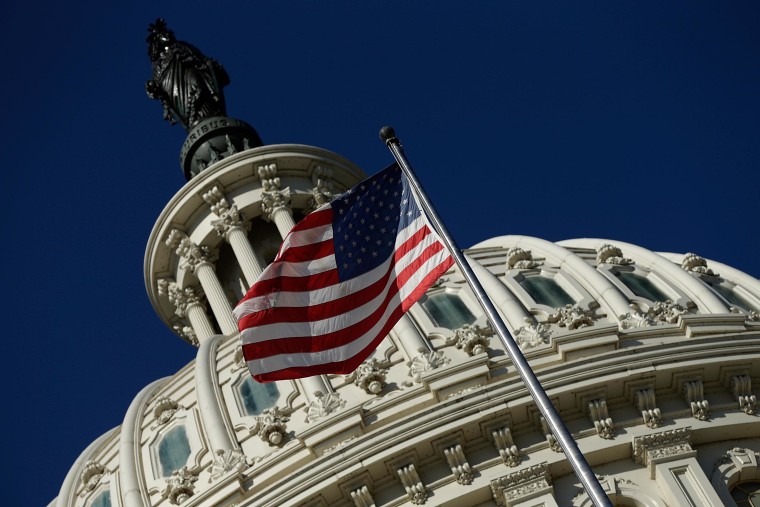Yes, America is full of red states and blue states, but there are many shades in that spectrum and behind those hues are very different drivers. In some states liberal or conservative views are driven by economic issues and in some states they are pushed by social/cultural concerns.
So to get a feel for the various shades of liberal and conservative America, "Meet the Press" and the American Communities Project at American University looked at where the 50 states stand on five key issues – gay marriage, gun control, minimum wage, marijuana and abortion laws – as well as their presidential voting history since 2008 to create a kind of MTP Liberal/Conservative Index.
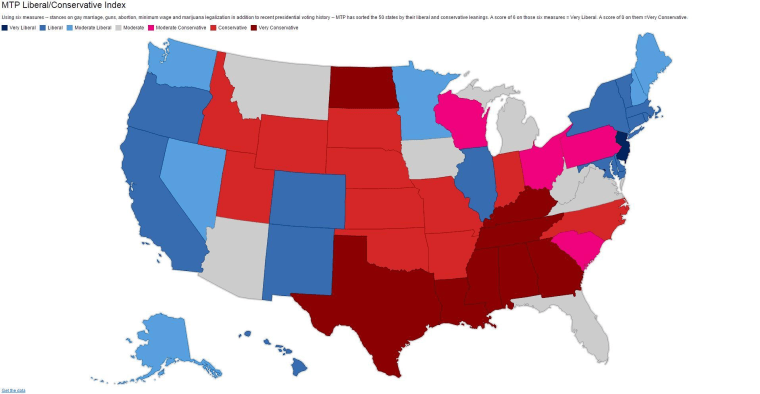
That map, which can be seen here, adds a few insights to the traditional understanding of politics in America – where the states sit on a kind of left-right continuum. The map doesn’t just measure votes, in a broad way it measures attitudes. Among the most liberal states is New Jersey as well as the states of the Northeast and the West Coast. And there is a strong streak of social conservatism running up through the middle of the country.
The issues in the MTP Index are not a proxy for all of the issues facing the country, but they offer a good cross-sample of some of the nation’s key dividers. And the map they create shows the country is more complicated than many people believe with surprising splits on some issues.
Gay Marriage: Some of the biggest news this week came from Florida, where the state became the 36th to legalize some form of same-sex union. With that news, more than 70% of Americans now live in a state where those unions are allowed by law.
Look at this map, though, and you’ll still see some important holdouts, including Texas. (Note: Same-sex couples in Michigan and Arkansas were legally married before a court stay put legal unions on hold.)
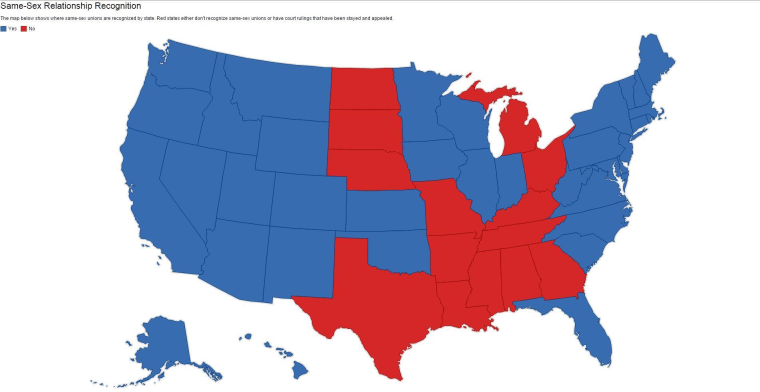
That map isn’t all about attitudes across the states, of course. For instance, Utah, Oklahoma, Wyoming and Kansas have legalized same-sex unions because of an appeals court ruling. Still, the gay marriage map at least offers a look at a line of states through the middle of the country where the “red” tint has a strong cultural component.
Marijuana: Four states truly stand out on this map – Washington, Oregon, Alaska and Colorado all allow for some recreational marijuana use.
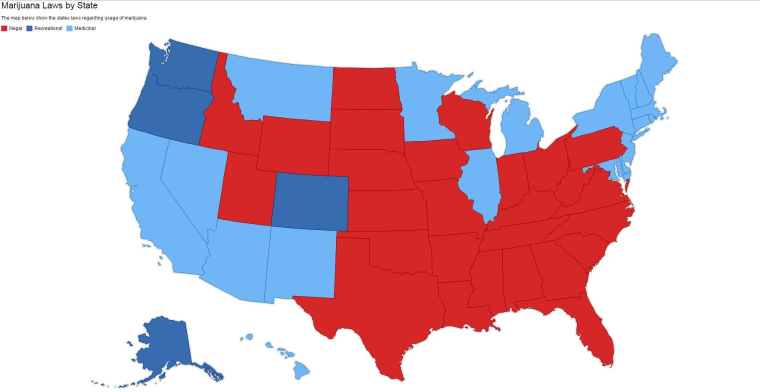
But when you add in the states that allow medicinal use, you see a big chunk of the familiar presidential maps of 2008 and 2012.
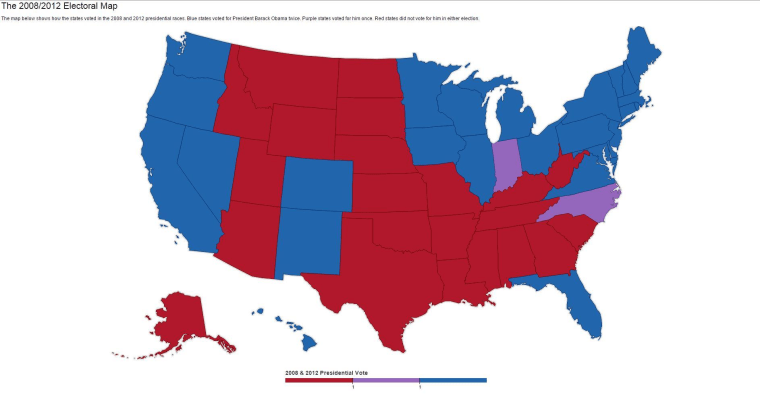
There are some notable Democratic exceptions, including Pennsylvania, Ohio, Iowa and Wisconsin, where marijuana is still illegal. And on the Republican side Alaska, Arizona and Montana buck the trend, with having some form of legalization. But in all those states the attitudes are somewhat revealing of the driving force behind the liberalism and conservatism in them.
On the Democratic side, older, whiter populations in Pennsylvania, Ohio, Iowa and Wisconsin give those places a more conservative bent. On the Republican side, Alaska, Arizona and Montana all feature a more libertarian streak of conservatism.
Minimum wage: This map regarding pay is one of the more interesting of the set. Some of the accepted lines in the blue/red divide don’t apply here. States considered reliably Republican, such as Arkansas, Missouri, Nebraska and South Dakota, have raised their minimum wages above the national figure. And some traditional unions strongholds, such as Pennsylvania and Wisconsin, have not.
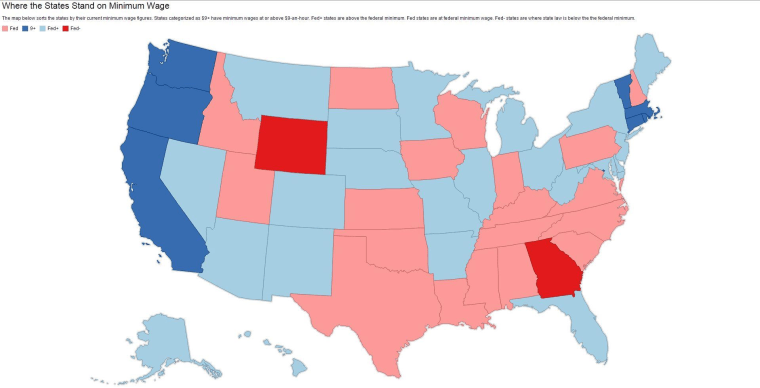
Some of those discrepancies may be driven more by differences in political leadership than need. Iowa, Wisconsin and Pennsylvania have all had Republican governors for the last four years.
It is worth noting, however that the West Coast and Northeast, generally sit above the national minimum – far above on the West Coast. The numbers show how interwoven the issues of politics and economics can be. Those states tend to have higher costs of living, so those higher minimum wages may be as much about financial realities and political leanings.
Abortion: Where states stand on the complicated matter of abortion is difficult to map. There are any number of different laws and permutations of laws that can apply. But for the MTP map we used the latest at which an abortion is allowed – and even with that measure there are questions of exceptions and qualifications.
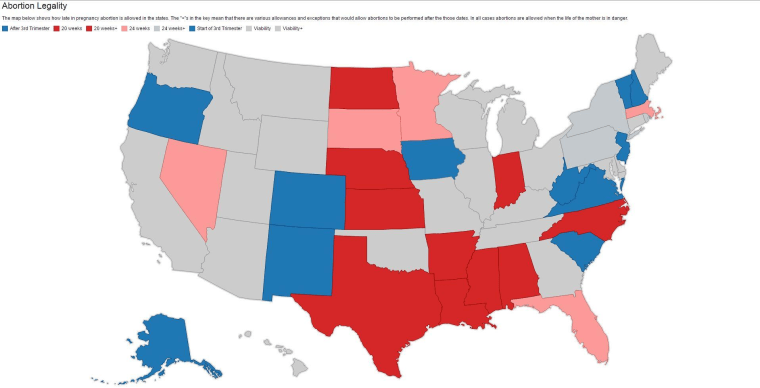
Looking at the map, the largely red core of the country, from the Dakotas to Texas, holds to form. But there are some states that again, seem to be exceptions. Massachusetts and Minnesota, traditionally Democratic, both have hard lines at 24 weeks. Alaska, West Virginia and South Carolina, consistently Republican in politics, are all on the liberal end of the spectrum by this measure.
Maybe most notable, however, may be how much gray dominates this map, perhaps reflecting the country’s conflicted feelings on the topic.
Guns: This map of gun laws shows how complicated the terrain around the issue can be. States such as Oregon and Vermont have less strenuous laws than states that are often thought of as their liberal kin, such as California and New York. One reason why, they are have large rural populations that like to hunt.
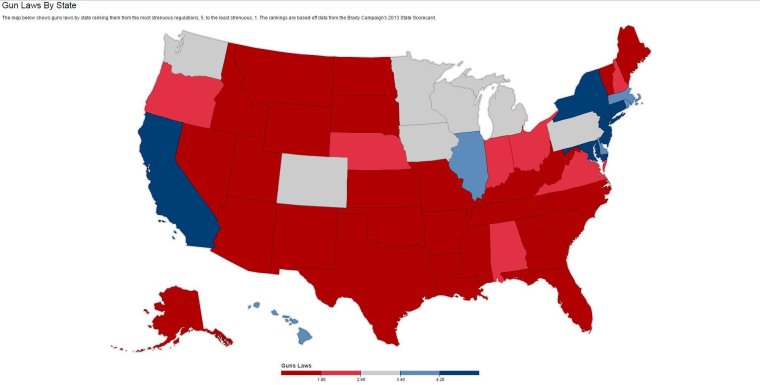
But states in the Midwest, also full of hunters, are more of a mixed bag, going by the rankings of the Brady Campaign, as is Colorado, which sits as a gray island in a sea of red.
Note, however, that as New England gets more populous and transitions to the Mid-Atlantic, the gun laws get stricter.
The point of all these maps, however, is a state’s liberal or conservative bent is a tricky thing. There are issues that sit outside of the norm in most states that are representative of its special brand of liberalism or conservatism.
Vermont may be the home of self-avowed Socialist Sen. Bernie Sanders, but no one will mind if you have a gun collection. And Alaska may be the home of former GOP Vice Presidential nominee Sarah Palin, but no one will mind if you have a bong.
Beyond providing material for snickering however, these maps help explain why Wisconsin may indeed be close again in the 2016 presidential race, why Colorado still looks pretty reliably blue and Florida remains a quintessential toss-up.
